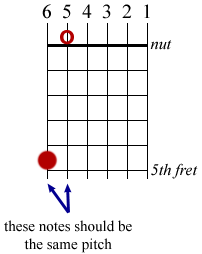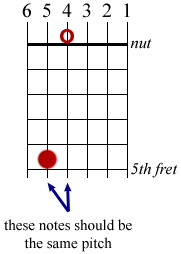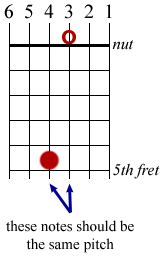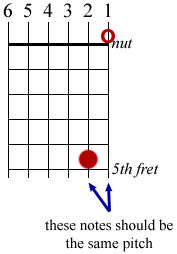Tuning your Acoustic Guitar
Tuning may be the most important thing when learning to play an Acoustic Guitar. If you aren’t in tune, you will never sound good, no matter how incredible a player you are, everything and absolutely everything sounds like garbage. These pages are designed to teach you how to tune your guitar. Follow them step-by-step and you will be able to tune quickly and easily, without the need for an expensive electronic tuner.
The goal of tuning is to put your strings in tune with each other. You strings should be tuned to the following notes (low-to-high): EADGBE. This is called “standard tuning.” There are many other possible tunings, but I will not discuss those here.
The first step in tuning is to get a reference pitch. This will be the E on your sixth string. The accuracy of your tuning to this pitch when playing alone is relatively unimportant; I tend to tune to a pitch slightly below this to help me sing higher notes more easily. However, if you are playing in a group, it is absolutely imperative that you all tune to the same reference pitch, because if you don’t you will all be out of tune with each other.
The sound file below is an E on your sixth string. Tune your sixth string to it before you go on. To do this, play the pitch, then tune your 6th string until the pitch sounds exactly like the file. You may have to turn up your speaker volume to be able to hear the file well enough to tune.
Once you have tuned your sixth string to E, you can tune your fifth string to A based on your sixth string. Refer to the image below as you do this. It’s very simple, and the hardest part will be making sure that the open fifth string pitch sounds EXACTLY like the fretted sixth string. The procedure goes like this:
- Fret your sixth string at the 5th fret.
- Tune your open fifth string until it sounds exactly like the fretted sixth string.
Why does this work? Well, the sixth string 5th fret is an A, which is the same note as your open fifth string. Once you’re done, move on to the fourth string.
Tuning Your Fourth String
Once you have tuned your fifth string to A, you can tune your fourth string to D based on your fifth string. The procedure is exactly the same, but we’ve moved up a string:
- Fret your fifth string at the 5th fret.
- Tune your open fourth string until it sounds exactly like the fretted fifth string.
Why does this work? Well, the fifth string 5th fret is a D, which is the same note as your open fourth string. Once you’re done, move on to the third string.
Tuning Your Third String
Once you have tuned your fourth string to D, you can tune your third string to G based on your fourth string. The procedure is exactly the same, but we’ve moved up another string:
- Fret your fourth string at the 5th fret.
- Tune your open third string until it sounds exactly like the fretted fourth string.
Why does this work? Well, the fourth string 5th fret is a G, which is the same note as your open third string. Once you’re done, move on to the second string.
Tuning Your Second String
Once you have tuned your third string to G, you can tune your second string to B based on your third string. The procedure is similar, but this time we use the fourth fret instead of the fifth:
- Fret your third string at the 4th fret.
- Tune your open second string until it sounds exactly like the fretted third string.
Why does this work? Well, the third string 4th fret is a B, which is the same note as your open second string. Once you’re done, move on to the first string.
Tuning Your First String
Once you have tuned your second string to B, you can tune your first string to E based on your second string. We now return to fretting at the fifth fret:
- Fret your second string at the 5th fret.
- Tune your open first string until it sounds exactly like the fretted second string.
Why does this work? Well, the second string 5th fret is an E, which is the same note as your open first string.
You have now tuned your guitar! You may have to go back and slightly re tune certain strings to sound exactly right, but this will usually get you close enough. Just make sure you are as accurate as possible when tuning. Good luck, and if you have any questions, please let me know.






